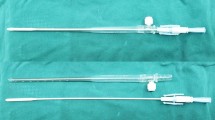Abstract
Background
Selective cerebral perfusion avoids deep hypothermic circulatory arrest in single-stage repair of the aortic arch and associated cardiac defects in neonates and infants. Direct innominate artery cannulation is accepted as a safe technique to obtain this objective.
Methods
From February 2012 to September 2014, 21 patients underwent one-stage repair of aortic arch anomalies associated with intracardiac defects. The age ranged from 16 days to 1 year (median age 2 months). There were six neonates. The weight ranged from 2.4 to 8 kg (median weight 3.5 kg).Two infants had coarctation with diffuse aortic arch hypoplasia, without any associated intracardiac defect. The rest had significant intracardiac defects which were corrected along with arch repair. Cardiopulmonary bypass was initiated with direct arterial return through the base of the innominate artery and routine venous cannulation. All patients were cooled to 24 °C. The arch repair was done using selective cerebral perfusion through the innominate artery with a flow rate of 40 mL/kg/min. After the arch repair, normal bypass was reestablished and intracardiac defects were repaired.
Results
There was no mortality. There was no evidence of obvious neurologic injury. All patients had unobstructed flow in the arch repair during intermediate follow-up.
Conclusions
Selective cerebral perfusion with direct innominate artery cannulation for arch repair extends the safety of arch repair. The major advantage of this technique is the feasibility to perform a wide end to side anastomosis without space constraint and ability to repair associated cardiac lesions.





Similar content being viewed by others
References
Newburger JW, Jonas RA, Wernovsky G, et al. A comparison of the perioperative neurologic effects of hypothermic circulatory arrest versus low-flow cardiopulmonary bypass in infant heart surgery. N Engl J Med. 1993;329:1057–64.
Bellinger DC, Jonas RA, Rappaport LA, et al. Developmental and neurological status of children after heart surgery with hypothermic circulatory arrest or low-flow cardiopulmonary bypass. N Engl J Med. 1995;332:549–55.
Oates RK, Simpson JM, Turnbull JAB, Cartmill TB. The relationship between intelligence and duration of circulatory arrest with deep hypothermia. J Thorac Cardiovasc Surg. 1995;110:786–92.
Asou T, Kado H, Imoto Y, et al. Selective cerebral perfusion technique during aortic arch repair in neonates. Ann Thorac Surg. 1996;61:1546–8.
McElhinney DB, Reddy VM, Silverman NH, Hanley FL. Modified Damus-Kaye-Stansel procedure for single ventricle, subaortic stenosis, and arch obstruction in neonates and infants: midterm results and techniques for avoiding circulatory arrest. J Thorac Cardiovasc Surg. 1997;114:718–25.
Pigula FA, Siewers RD, Nemoto EM. Regional perfusion of the brain during neonatal aortic arch reconstruction. J Thorac Cardiovasc Surg. 1999;117:1023–4.
Tchervenkov CI, Chu VF, Shum-Tim D, Laliberte E, Reyes TU. Norwood operation without circulatory arrest: a new surgical technique. Ann Thorac Surg. 2000;70:1730–3.
Lim C, Kim WH, Kim SC, et al. Aortic arch reconstruction using regional perfusion without circulatory arrest. Eur J Cardiothorac Surg. 2003;23:149–55.
Lim HG, Kim WH, Jang WS, et al. One-stage total repair of aortic arch anomaly using regional perfusion. Eur J Cardiothorac Surg. 2007;31:242–8.
Nasirov T, Mainwaring RD, Reddy VM, Sleasman J, Margetson T, Hanley FL. Innominate artery cannulation and antegrade cerebral perfusion for aortic arch reconstruction in infants and children. World J Pediatr Congenit Heart Surg. 2013;4:356–61.
Mainwaring RD, Lamberti JJ. Mid- to long-term results of the two-stage approach for type B interrupted aortic arch and ventricular septal defect. Ann Thorac Surg. 1997;64:1782–6.
Kostelka M, Walther T, Geerdts I, et al. Primary repair for aortic arch obstruction associated with ventricular septal defect. Ann Thorac Surg. 2004;78:1989–93.
Flint JD, Gentles TL, MacCormick J, Spinetto H, Finucane AK. Outcomes using predominantly single-stage approach to interrupted aortic arch and associated defects. Ann Thorac Surg. 2010;89:564–9.
Tchervenkov CI, Korkola SJ, Shum-Tim D, et al. Neonatal aortic arch reconstruction avoiding circulatory arrest and direct arch vessel cannulation. Ann Thorac Surg. 2001;72:1615–20.
Amir G, Frenkel G, Shukrun G, et al. Direct innominate artery cannulation for antegrade cerebral perfusion in neonates undergoing arch reconstruction. Ann Thorac Surg. 2013;95:956–61.
Sasaki T, Tsuda S, Riemer RK, Ramamoorthy C, Reddy VM, Hanley FL. Optimal flow rates for antegrade cerebral perfusion. J Thorac Cardiovasc Surg. 2010;139:530–5.
Amir G, Ramamoorthy C, Riemer RK, Davis CR, Hanley FL, Reddy VM. Visual light spectroscopy reflects flow related changes in brain oxygenation during regional low-flow perfusion and deep hypothermic circulatory arrest. J Thorac Cardiovasc Surg. 2006;132:1307–13.
Amir G, Ramamoorthy C, Riemer RK, Reddy VM, Hanley FL. Neonatal brain protection and deep hypothermic circulatory arrest: pathophysiology of ischemic neuronal injury and protective strategies. Ann Thorac Surg. 2005;80:1955–64.
Author information
Authors and Affiliations
Corresponding author
Additional information
Accepted for oral presentation in the IACTS February 2015 Annual Conference.
Rights and permissions
About this article
Cite this article
Dharmapuram, A.K., Ramadoss, N., Goutami, V. et al. Single-stage repair of aortic arch and associated cardiac defects with antegrade cerebral perfusion using direct innominate artery cannulation in neonates and infants. Indian J Thorac Cardiovasc Surg 31, 127–132 (2015). https://doi.org/10.1007/s12055-015-0367-4
Received:
Revised:
Accepted:
Published:
Issue Date:
DOI: https://doi.org/10.1007/s12055-015-0367-4




